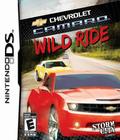The Nintendo DS will go down in gaming history as a console filled with excellent sprite-based games, great RPGs, wonderful platformers, and a few other games that are good genre representatives. It will also go down as a console with a plethora of terrible and mediocre racing titles. From ATV racers to sports cars to trucks to motorcycles, the DS has no shortage of games that do a disservice to those vehicles. For every Ridge Racer DS, Mario Kart DS or Sonic & Sega All-Stars Racing, there are plenty of other racing titles that fall far below expectations. Racers based on one brand of vehicle are no exception, as there hasn't been a good one on the console yet, and the release of Chevrolet Camaro: Wild Ride for the Nintendo DS further cements this notion.
The game features five different gameplay modes, four of which count for unlocking items and general progression. Speed Limit asks you to choose a car and try to reach a target speed before the track ends. Cones has you bashing as many cones on the road as possible instead of avoiding them, and Checkpoints has you racing from one checkpoint to another on the track, giving you bonus time when you make it and ending the mode if you run out of time before passing another checkered gate. The modes are basic, but since it's just you racing alone, it turns out to be slightly enjoyable. That all changes when you encounter the game's other major mode.
Competition mode is the standard racing mode you'll find in just about every other racing game to date. You go up against four other cars in a three-lap race, and your objective is to come in first at all times. You have three tiers to choose from, and each tier contains three different tracks for a total of nine tracks.
Racing in this mode uncovers a plethora of flaws stemming from the gameplay alone. The first is that the enemy AI is way too aggressive. From the start of the race, you'll see each of your opponents fly off in front. You'll be able to catch up, but the game logic dictates that rubber band AI come into play, keeping each race close. The issue stems from each car only following one racing line, and they will aggressively keep pushing you if you're in front until you pull up further or they take the lead again. It gets aggravating to constantly see your opponent riding your bumper, and it's irritating to see your opponent win at the last moment in just about every race.
The track design is also arbitrarily difficult. More often than not, sharp turns come in from blind spots such as hill descents, always forcing you into the wall. Combine that with the enemy AI always wanting to pin you to those walls when it gets close, and soon the act of basic racing loses all of its fun. Finally, while there are a plethora of cars available, each one doesn't feel too different from the last, so your car choice is based more on looks than actual performance.
The completion of any track in these modes gives the player a certain number of Camaro points, depending on how well they play. Reaching certain point milestones not only unlocks the other tracks in the game but other tiers as well. It also unlocks other, faster Camaro models for you. The system is solid, but the sense of progression is not due of the lack of visual feedback. Replaying any mode on a track that you've already conquered won't give you more Camaro points beyond what you've already been granted. That mechanic is fine, but what will frustrate players is that the player is given no indication that he's already played a mode on a particular track. Considering the number of tracks and tiers in the game, you'll often find yourself wasting time on something you've already beaten and likely won't realize it until you reach the end and see that you've either gained 1 or 0 points for your efforts. For those who have endured everything else the game has thrown at them, this may be the final straw.
Time Trial is the only mode that doesn't give you a reward for completing it. Here, you pick among unlocked cars and tracks to score the fastest possible lap time. It's a familiar mode, but again, since nothing is gained aside from bragging rights, it gives little incentive for the player to conquer every track. Even worse is the fact that without an online leaderboard, there's even less incentive to try it, relegating the mode to something that will barely be played by most gamers.
The controls are questionable at best because of two quirks. The first is the vehicle handling. For some reason, turning with any vehicle goes from slow to out of control in a matter of moments. There's no smooth transition in the turning, and while people won't exactly fishtail all over the place, it will catch players off guard when they first encounter it. The second is the placement of the turbo, which is mapped to the Y button. It doesn't sound so bad until you realize that the gas is the A button, the braking is done with the B button, and there's no way to customize the layout. In essence, you have to disengage from the gas to activate the turbo; it seems awkward because other racing games let you hit the turbo while still activating the gas. Going against the norm is fine, but when you do it for no good reason, it's not acceptable.
At first glance, the graphics don't look too bad. The environments look decent, and the cars look OK despite not having much detail. When everything moves, though, things go bad quickly. Every environment suffers from the fogging effect prevalent in most Nintendo 64 games, and while the fog is kept at bay, its presence is disturbing nonetheless. The little touches, like reflections on the car, are nice but you'll immediately see flaws in the strangest places. The rear window, for example, is fragmented to the point where clouds reflecting from it are split in the middle. The reflection of the sky in the middle seems to go sideways instead of forward, and the whole thing looks like it's about to burst open from the middle.
The worst aspect, though, is the clipping. Because of opponent AI, you'll often see cars creep up behind you and try to run you over because of the clipping effect. Enemy cars even overtake you simply because the cars clip into each other too much, pushing previously lagging cars in front of you and, in some cases, costing you points and a race. You'll also notice unusual bounces in the camera because of it, creating the effect of an off-road racer although you're using speed vehicles. With no redeeming qualities, the graphics in motion are a mess from beginning to end.
The sound in the game is terrible. The musical soundtrack seems to consist of a small handful of generic rock tracks that play constantly, from the menu to the race track. For some odd reason, though, the music stops playing when more than one car is around, and it is a shame since it would help drown out the effects. All of the cars seem to have the same droning engine sound as they race, and the volume is only amplified when more than one car is in the vicinity of your vehicle. Tire screeches sound fine, but the bashing of one car against another is irritating, as it sounds less like metal scraping together and more like chalkboard scratches. This is certainly one title for which muting the sound is more than just good advice.
Chevrolet Camaro: Wild Ride for the Nintendo DS offers less than its home console counterpart, and it also manages to be worse. The controls don't feel like they've been thought out very well, and the sound grates the ears. The graphics look bad and cause a few issues in the gameplay department as well. The progression system is never made clear to players, the track design is sub-par, and there's no multiplayer to give this game a modicum of replay value. There's no reason for anyone to even look at the title, let alone play it for more than one lap.
Score: 3.5/10
More articles about Chevrolet Camaro: Wild Ride











 Test your mettle against other drivers through treacherous tracks across three continents. Choose one of 12 Camaro vehicles to pilot in models ranging from 1971 to modern-day. Take in the sights as you cruise through the famous landmarks in Asia, Europe and the U.S.
Test your mettle against other drivers through treacherous tracks across three continents. Choose one of 12 Camaro vehicles to pilot in models ranging from 1971 to modern-day. Take in the sights as you cruise through the famous landmarks in Asia, Europe and the U.S.







